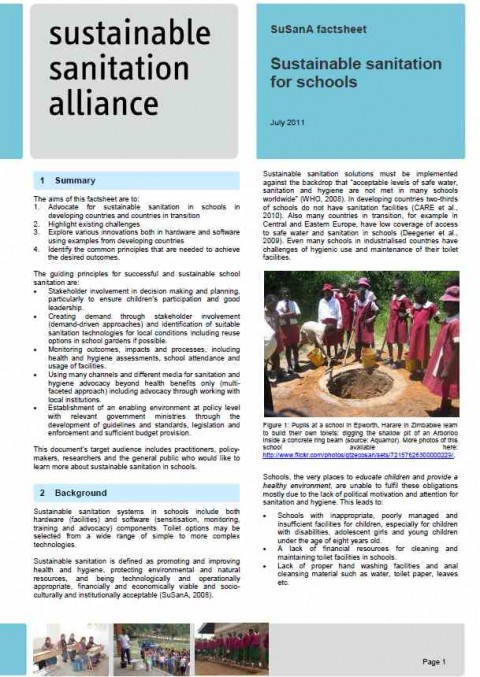Sustainable sanitation for schools - Factsheet of Working Group 7a (old version, new version was published in 2018)
Abraham, B. et al. (2012)

Published in: 2012
Publisher:
Sustainable Sanitation Alliance (SuSanA)
Author:
Abraham, B. et al.
Uploaded by:
SuSanA secretariat
Partner profile:
common upload
11423 Views
313 Downloads
The aims of this factsheet are to:
1. Advocate for sustainable sanitation in schools in developing countries and countries in transition
2. Highlight existing challenges
3. Explore various innovations both in hardware and software using examples from developing countries.
4. Identify the common principles that are needed to achieve the desired outcomes.
The guiding principles for successful and sustainable
school sanitation are:
· Stakeholder involvement in decision making and planning, particularly to ensure children’s participation and good leadership.
· Creating demand through stakeholder involvement (demand-driven approaches) and identification of suitable sanitation technologies for local conditions including reuse options in school gardens if possible.
· Monitoring outcomes, impacts and processes, including health and hygiene assessments, school attendance and usage of facilities.
· Using many channels and different media for sanitation and hygiene advocacy beyond health benefits only (multi-faceted approach) including advocacy through working with local institutions.
· Establishment of an enabling environment at policy level with relevant government ministries through the development of guidelines and standards, legislation and enforcement and sufficient budget provision.
This document’s target audience includes practitioners, policy-makers, researchers and the general public who would like to learn more about sustainable sanitation in schools.
Bibliographic information
Abraham, B. et al. (2012). Sustainable sanitation for schools - Factsheet of Working Group 7a (old version, new version was published in 2018). Sustainable Sanitation Alliance (SuSanA)
Filter tags
English Factsheets and policy briefs Journalists Publications by SuSanA Schools















